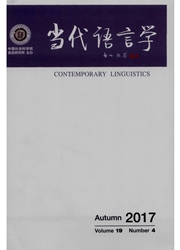

 中文摘要:
中文摘要:
本文以37种汉语方言作为样本,对汉语方言的定指“量名”结构进行类型学考察。在区分准冠词型定指“量名”结构和准指示词型定指“量名”结构的基础上,文章从独立使用和受到修饰的不同表现、“量名”结构进入不同句法位置的条件、不同量词类别对“量名”结构成立的影响和量词独用表定指与“量名”表定指的差异性这四个方面入手讨论,得到了汉语方言定指“量名”结构的6条共性。
 英文摘要:
英文摘要:
This article is a typological study of the definite classifier-noun constructions ( henceforth DCINCs) based on the data from 37 Chinese dialects. It is proposed that there are two types of DCINCs in Chinese dialects. The first one is termed quasi-article DCINCs, which syntactically and semantically pattern like determiner phrases, and the other type is called quasi-demonstrative DCINCs, which are claimed to be a noun phrase containing an omitted demonstrative. The major difference between quasiarticle DCINCs and quasi-demonstrative DC1NCs lies in the ability to indicate distance. The former, like true DPs, are irrelevant to distance specification, while the latter are not. Therefore, the two types can be then distinguished by certain contrastive context. As shown in (1), the quasi-article DC1NC, on a par with a determiner phrase, cannot be contrasted with a demonstrative ClP, whereas the restriction is not found in ( 2), where a quasidemonstrative DC1NC is contrasted with a ClP anteceded by an overt demonstrative.' You sit on this stool, and I sit on that stool.' Other criteria for distinguishing them also hinge crucially on the distinction between determiner phrases and demonstrative phrases. Having given a detailed description of the two types of DCINCs, we then propose 6 language universals: 1) If a bare quasi-article DCINC can be used alone, then it can be modified. On the contrary, if a quasi-demonstrative DCINC can be modified, then it can be used alone. 2) If a DCINC can be modified by non-possessive attributive, then it can also be modified by possessive attributive. 3) If a bare DCINC can be used in postverbal position, then it can also be used in preverbal position. 4) If a DCINC can be headed by a non-general classifier, then it can be headed by a general classifier. 5) If the classifier can denote definiteness without taking a noun as its complement, the CIP it heads must be quasi-demonstrative DCINC. 6) If a modified bare classifier without complement noun can denot
 同期刊论文项目
同期刊论文项目
 同项目期刊论文
同项目期刊论文
 期刊信息
期刊信息
